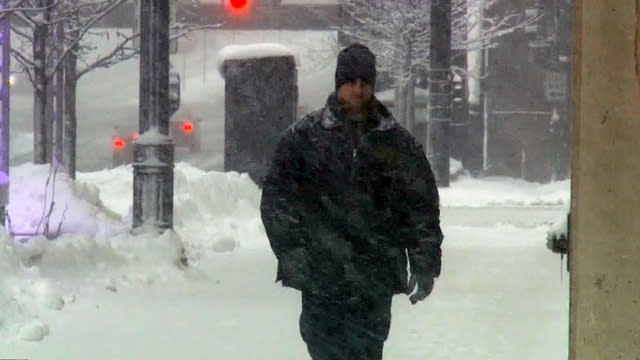Alaska storm could spread chill across U.S.
A huge storm headed for Alaska's Aleutian Islands could bring frigid weather to much of the U.S. next week.
How cold will it get? »
Intense storm headed to Alaska's Aleutian Islands
ANCHORAGE, Alaska (AP) — An explosive storm surpassing the
intensity of 2012's Superstorm Sandy is expected to reach Alaska's
western Aleutian Islands over the weekend and bring unseasonably frigid
temperatures to much of the U.S. next week, weather forecasters said
Thursday.
What remains of Typhoon Nuri is moving northeast
from off the Japanese coast and is mixing with cold air and the jet
stream, which will give it the power to produce hurricane-force winds
and waves 50 feet high. It could arrive late Friday or Saturday before
weakening in the Bering Sea, the National Weather Service said.
The storm potentially could be one of the most intensive to ever hit the North Pacific, weather service forecaster Brian Hurley said. The Coast Guard and Alaska state emergency responders were keeping a close eye on its strength.
The system is expected to push cold air into much of the lower 48 states next week, forecaster Bob Oravec said. By the weekend, high temperatures in Minneapolis will only reach the upper 20s, and mid-30s are expected in Chicago — more than 15 degrees below normal.
Snow also is coming to areas including the northern Rockies and northern Plains.
"It looks like winter's starting early," Oravec said.
 While Sandy caused destruction along the urban East Coast,
Nuri's target in the north is a sparsely populated region with a few
small communities that are accustomed to severe weather.
While Sandy caused destruction along the urban East Coast,
Nuri's target in the north is a sparsely populated region with a few
small communities that are accustomed to severe weather.
In fact, 69 mph wind gusts blew in last week in the western Aleutian town of Adak, a former Naval Air Station east of Nuri's direct route that retains its military appearance. To prepare for the storm, the community's 100 year-round residents were tying down loose items like picnic tables, storage containers and pallets, and parking cars differently so doors won't get blown off, city manager Layton Lockett said.
A multiuse building that houses the town's school can also be used as an emergency center if necessary.
"If it gets really bad, you know, everybody'll come over here, camp out a little bit, have fun and drink cocoa," Lockett said.
The storm's path includes a busy maritime route for cargo ships traveling to or from Asia, as well as the red king crab fishery made famous by the Discovery Channel reality show "Deadliest Catch." Vessels are finding protected harbors or moving away from the path, according to Brett Farrell with the Marine Exchange of Alaska, a nonprofit maritime organization. No one in their right mind would stick around that area, he said.

The storm potentially could be one of the most intensive to ever hit the North Pacific, weather service forecaster Brian Hurley said. The Coast Guard and Alaska state emergency responders were keeping a close eye on its strength.
The system is expected to push cold air into much of the lower 48 states next week, forecaster Bob Oravec said. By the weekend, high temperatures in Minneapolis will only reach the upper 20s, and mid-30s are expected in Chicago — more than 15 degrees below normal.
Snow also is coming to areas including the northern Rockies and northern Plains.
"It looks like winter's starting early," Oravec said.
View gallery
In this photo provided by NASA, The eruption of the Cleveland Volcano is seen as photographed by an …
In fact, 69 mph wind gusts blew in last week in the western Aleutian town of Adak, a former Naval Air Station east of Nuri's direct route that retains its military appearance. To prepare for the storm, the community's 100 year-round residents were tying down loose items like picnic tables, storage containers and pallets, and parking cars differently so doors won't get blown off, city manager Layton Lockett said.
A multiuse building that houses the town's school can also be used as an emergency center if necessary.
"If it gets really bad, you know, everybody'll come over here, camp out a little bit, have fun and drink cocoa," Lockett said.
The storm's path includes a busy maritime route for cargo ships traveling to or from Asia, as well as the red king crab fishery made famous by the Discovery Channel reality show "Deadliest Catch." Vessels are finding protected harbors or moving away from the path, according to Brett Farrell with the Marine Exchange of Alaska, a nonprofit maritime organization. No one in their right mind would stick around that area, he said.
View gallery
This Nov. 5, 2014 photo provided by NASA shows a picture captured by NASA's Aqua satellite of Ty …
With most of the red king
crab quota caught, the season is winding down, said Mark Gleason,
executive director of the Seattle-based trade association Alaska Bering
Sea Crabbers. He said the coming storm is huge but the fleet has decades
of experience dealing with severe conditions. Crews will hunker down
and wait out the weather, then move on and do the job that needs to be
done, he said.
"This isn't some kid's sailing class," Gleason said. "These guys are professionals. They know what they're doing."
Officials
are also closely watching the western coast of Alaska's mainland,
according to Jeremy Zidek, a spokesman for the state Department of
Homeland Security and Emergency Management. Fall storms routinely batter
many coastal communities, and erosion has long been a problem.
___
AP Science Writer Seth Borenstein in Washington, D.C., contributed to this report.
___
Follow Rachel D'Oro at https://twitter.com/rdoro .
View Comments (1608)
end quote from:

No comments:
Post a Comment